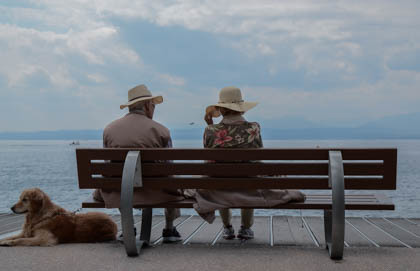Like most North Americans, I studiously avoided the subject of death and dying until I experienced the final months, weeks, days and hours at the bedside of each of my dying parents. They died a decade apart, and in very different contexts; so different, it has caused me to reflect on how their deaths are illustrative of two contrasting philosophies and approaches to death and dying in Canada.
When my 79-year-old mother went into a Calgary hospital with pneumonia, my family had no idea that the doctors would discover stomach cancer and that she would never come home. Following surgery, we visited her on a Tuesday evening, and the next morning when my sister and I went to visit her, she was in a coma. None of the nurses had an explanation. The doctor was unavailable. We did not obtain any information about why she went into a coma until Friday evening when we finally saw the doctor.
Meanwhile, she was on life support, and nurses in the hospital virtually ignored her. They were less than enthusiastic about our persistent questions and requests to see the doctor to obtain more information. We later realized that the nurses had information about our mother's condition but were not allowed to pass it on to us. That was the doctor's prerogative. They knew she was dying but would not or could not discuss this with us. That experience of sitting at her bedside for days with very little information was one I will never forget.
Then the doctor asked for our permission to make another "heroic" effort to revive her with an injection. To no avail. That is when, as a family, we made the decision to acknowledge that she was not coming back. What was the point of further "extraordinary measures"? We requested that her intravenous be removed. We gathered the family around her bedside, held hands and sang hymns and said prayers. The nurses took note. A few of them said they had never seen a family do that before in the hospital. My mother passed away with my sister and me at her side the following evening. But the experience of having a loved one die in a hospital was challenging for several reasons. A hospital is geared to keeping people alive. Hospital staff are trained to treat illness and bring about recovery. When that is clearly not going to occur, hospital staff are not trained to transition into a different mode. Unless they are specially trained palliative care staff, they are in uncomfortable territory.
"Death and dying are difficult for nurses and doctors, too," says Donna Wilson, professor of nursing at the University of Alberta. "In hospitals, the emphasis is on saving people, so they are not set up for death and dying."
A decade later, when my father's cancer became terminal, we met with a palliative care representative from Alberta Health Services. She urged us to move Dad into a hospice rather than see him decline in a hospital setting. We were surprised at how strongly she presented her case. But then, recalling how our mother was virtually ignored while in a coma, how little information we were able to glean about her condition, how hard it was to even see a doctor for days on end, how many efforts were made to turn things around when clearly she was dying, we opted to have my dad moved into a hospice.
Hospice care in Alberta is covered by Alberta health insurance. We came to appreciate what a gift that was to our family. In the United States, only people with means or platinum health insurance plans are able to access hospice care. Across Canada, there is great variance in access to hospice or palliative care among provinces and between rural and urban residents.
Most hospice stays are two to three weeks maximum, we were told. My dad outlasted that prediction and spent three months in hospice. During that time, my family visited him on a daily basis, and we were amazed at the level of emotional as well as physical care he received.
The experience of observing a loved one die in a hospital versus a hospice illustrates two very different views and understandings of death. Dylan Thomas' famous line, "Do not go gentle into that good night… Rage, rage against the dying of the light," best describes how death is regarded in a hospital context. Everything possible is done to prevent it. The place is collectively wired to rage against death.
There is a sense that when a death occurs in a hospital, it is deemed a failure. Something went very wrong, and the hospital was unable to successfully intervene. Battleground terminology is used. The patient "lost" the battle with cancer. The doctor has "lost" a patient. For the patient and family, in that context, death is truly the Grim Reaper.
Elisabeth Kübler-Ross wrote of dying, death and the grief after death in very different terms. She understood it as a profoundly significant process as opposed to a single event. Her description of the five stages of grief—denial, anger, bargaining, depression, acceptance—points to a recognition that, for patients and family members, there are emotional, spiritual, physical and mental stages to the dying process. In her landmark book On Death and Dying, she wrote, "For those who seek to understand it, death is a highly creative force. The highest spiritual values of life can originate from the thought and study of death."
A hospice is a place where there is a keen awareness of these stages, for the patient and for family members. There is preparation, instruction, assistance, medication and support based on palliative care expertise. A hospice is a place for patients and families to come to terms with dying and death. It is intentionally and self-consciously different from a hospital ward. The staff are trained palliative care professionals. The doctors are specialists in palliative care. Whereas hospitals are geared to keeping people alive, at hospices death is regarded as a natural part of life. Hospices ease people's experience of dying. There is no intent to either hasten or postpone death.
Proponents of physician-assisted suicide (PAS) and euthanasia argue that each of us has the right to "die with dignity," to retain autonomy and self-control, to use the fear of pain and of the dying process, to assert the right to die as one chooses and when one chooses. Their key concepts are "autonomy," "control" and "right." "Dying with dignity" is really "dying with self-control." Loss of control over bodily functions, including brain functions, and the experience of pain and suffering are all deemed to contribute to a loss of dignity. These are Western concepts, ones that are philosophically removed from a view of the person and of life as sacred.
But this is a mistaken notion of dignity.
All persons have inherent dignity by virtue of being human beings created in the imago Dei, image of God. Control over one's death does not add dignity; it is already present. If death is a natural part of life, then death, too, is sacred.
If the notion of loss of control of bodily functions and pain constitute a loss of dignity, then birth also qualifies as an experience where there is loss of dignity. In fact, every birth should be deemed "birth without dignity." Ask any woman who has borne a child how dignified the birth process is. There is great pain. There is sometimes a loss of control of bodily functions. The mother is in an extremely undignified physical position. It is messy, noisy and painful, both for the mother and for the child making its way through the birth canal. There is nothing "dignified" about birth. But we recognize it as a beautiful event, a necessary part of life; the end result of a baby seems to compensate for all of the attendant indignities. It is all worth it. Most mothers forget to lament and bemoan the indignities when the newborn is gently placed in her arms.
At the other end of the life spectrum, however, our Western culture has come to view death as that which we rage against our whole lives. We fiercely fight off signs of aging. We lie about our age. We warehouse the aged behind walls of seniors' residences. We hate to be reminded of our mortality. We do not see death, we do not discuss death, and we do not prepare for death. We view death itself as an indignity.
How different this is from our approach to birth. We prepare for birth. We discuss birth. We go to Lamaze classes and learn how to breathe through the delivery, how to control our own pain. And we accept the "indignities" of birth as a natural part of the life cycle.
West Kelowna resident and amyotrophic lateral sclerosis (ALS, or Lou Gehrig's disease) patient Gloria Taylor recently won the right to access PAS through the B.C. Supreme Court because her disease would leave her too disabled to take her own life in the final stages. In fact, Taylor died in early October of an infection from a perforated colon. She died peacefully, according to media reports. Like her, however, many ALS patients believe that their deaths will be particularly bad because of the degenerative nature of the disease.
"ALS patients have similar challenges at the end to palliative cancer patients, but there are other challenges," says Dr. Ron Spice, a family physician and a palliative care consultant with Alberta Health Services. "There is shortness of breath, problems with secretions, swallowing, choking, and often communication issues. They often can't talk.
"The severity of the symptoms isn't more complicated to deal with, symptom by symptom," he adds. "One of the unique challenges is the slowness of the progression of the disease, meaning a longer course of palliative care."
Commenting about the case of Gloria Taylor, Spice said, "She talked about either being offered PAS or else she [would] die a horrible death. I beg to differ. That implies we have gone nowhere with our management of pain and symptoms in the end stage.
"We are pretty good at managing pain and shortness of breath," he adds. "We're good at not prolonging life. What a lot of people are most afraid of is disability, and that is a legitimate fear.
"The majority of people I see who die of significant chronic diseases do die in a way that is respectful of their wishes. It concerns me that promoters of PAS have coopted the word dignity.
"I am awestruck more than I am heartbroken when I see people die," he said. "For many, I am left wondering how they are so in control, so calm, peaceful, prepared and accepting.
"The most undignified deaths are the people who are fighting death all the way," Spice said. "They go to the hospital and ask for and receive aggressive treatment. Many die in a hospital bed with multiple measures being taken to try to fix the unfixable. It can be undignified."
So, people who have an undignified death are those who fear it and fight it, and that fear propels them to find ways to cheat death of the final suffering that they believe lies ahead. Hence the call for PAS. This illustrates that our culture places absolutely no value on suffering. Long held as a value in every religious and spiritual tradition, suffering used to be seen as a refining, strengthening and purifying process that enhanced compassion, humility and all of life. But in our present culture, suffering is unnecessary and must be avoided.
Having had the privilege of being at the bedside for the death of each of my parents, I can honestly say that there was a remarkable sense of peace, of understanding, that death was a transition point, a natural part of the journey that we all must undertake. Our family's Christian faith had everything to do with that sense of peace, our belief that there is life after death and that letting go of this mortal coil is necessary in order to experience new life on the other side.
In her 2010 report, Raising the Bar: A Roadmap for the Future of Palliative Care in Canada, Senator Sharon Carstairs reflected on her experience of being on the Special Senate Committee on Euthanasia and Assisted Suicide in 1994:
"I became convinced that before we could have a debate about euthanasia and assisted suicide in Canada we should be providing equitable access to quality, integrated palliative care. As a Committee, we were unanimous in our belief that what was needed was better care for the dying—better pain control, better training, and more research."
Almost 20 years later, the issue remains. Canadians across the country need better access to palliative care and hospices rather than dying in hospitals that have neither the space nor the philosophical capacity to provide the best end-of-life care and context. According to the Canadian Hospice Palliative Care Association, only 16 to 30 per cent of Canadians who die have access to or receive hospice palliative and end-of-life care services. Where Canadians live is a major factor in palliative care access.
About 250,000 Canadians die every year. As we are at the front end of the baby boomers reaching their senior and retirement years, that figure is projected to double sometime in the next 10 to 30 years. More of us will experience the deaths of loved ones. The discussion of death and dying is bound to become more common, more emotional and more political.
"It would be much easier to have the debate on PAS if we first knew that every Canadian had access to excellent palliative care," said Spice, echoing Carstairs' conclusion. "As a society, we need to make sure that the vast majority of Canadians have access to good basic palliative care before we put in place a system that helps a few rare cases seeking PAS."
Meanwhile, Canadians who are asked in surveys if they believe PAS should be legal in Canada, overwhelming say "yes" when they are not provided with accurate information. Many assume that dying a horrible, painful and "undignified" death is very common when in fact it is extremely rare. Many assume that they will not be able to refuse "extraordinary measures"—procedures or treatments that would unnecessarily extend their suffering—when this is not the case. Many have no idea that palliative sedation and care is very advanced, that pain and symptom management at the very end is sophisticated and largely successful.
But because there is a lack of information about these issues, and death is the subject everyone avoids, the PAS option is presented as a necessity when the need for it is largely obviated by excellent palliative care.
Terminus is a Latin word that literally means boundary stone. It may also be used to describe the end of a road. Similarly in our culture, death for some is truly the end of the road, with no hope or belief in anything beyond. Death is the end of the road we rage against. For those with faith and hope, however, death is a boundary stone we pass in the natural process of life as we transition into a new territory.
Chief Tecumseh expressed an approach to death that was the opposite of Dylan Thomas' rage against the dying light. He wrote:
"When your time comes to die, be not like those whose hearts are filled with fear of death, so that when their time comes they weep and pray for a little more time to live their lives over again in a different way. Sing your death song, and die like a hero going home."
By the end of his three months in hospice, my father was weary of his long stay at the last train station of life. Three days before he passed away, he said to me, "Why am I still here? I want to go home."
Then he went into the final stage of dying, where palliative sedation was provided. He received pain medication and muscle relaxants for "terminal restlessness," and for the next few days, my sister and I watched as the palliative treatment he received eased him peacefully to his death. It relieved his suffering. The palliative care nurses also provided care to us, family members, by explaining what was occurring and preparing us for what was to come. And so, finally, my 91-year-old father died peace-fully, like a hero, passing the boundary stone into a new territory.






